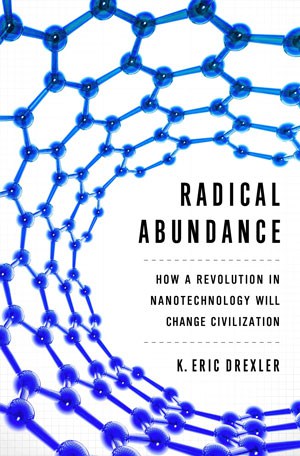The Foresight Institute was founded on the vision of nanotechnology put forward by Eric Drexler in his 1986 popular science work Engines of Creation, and clarified in his 1992 technical study Nanosystems. For the flavor of thinking about nanotechnology around 1987, see here and here. We’ve mentioned Drexler’s new book Radical Abundance here on Nanodot several times during the past year, for example here. Over at The Freeman, Phil Bowermaster discusses Radical Abundance in the context of the conversation about nanotechnology over the past 28 years — “The Reluctant Visionary“:
In 1959, Richard Feynman delivered a lecture with the provocative title “There’s Plenty of Room at the Bottom.” Speaking at a meeting of the American Physical Society at Caltech, the Nobel-laureate-to-be speculated about the possibility of manipulating matter at the atomic level via exquisitely small machines. Would it be possible, Feynman asked, for such machinery to configure atoms themselves, producing atomically precise outputs? Might we one day have billions of submicroscopic factories working in parallel to produce anything and everything we need?
It was a profound and exciting idea, and yet one that received very little serious attention in the years that followed, until an MIT student named K. Eric Drexler took up the cause in the 1980s. Working within Marvin Minsky’s MIT Media Lab, Drexler earned a Ph.D. in molecular nanotechnology—the first such degree ever awarded anywhere. Along the way he wrote the bestselling Engines of Creation (1986), which outlined his vision of nanotechnology for non-technical audiences, and the technical treatise Nanosystems (1991) [Note: Drexler’s PhD thesis, upon which Nanosystems is based, was completed in 1991; Nanosystems was published in 1992], which got into the nuts and bolts of nanotech.
Engines of Creation kicked off a worldwide nanotechnology craze. Corporations and universities began sponsoring research. Governments formed committees to develop technology roadmaps. Speculation in the media and popular culture grew ever wilder and more colorful, promoting images of tiny robots that could keep our clothes stain-free and our arteries unclogged, provided they didn’t go into an unstoppable feeding frenzy and reduce the entire world to a quivering mass of goo. Along with this buzz grew skepticism as to when and if we would ever see such technology, and whether molecular nanotechnology as described by Drexler was even possible. …
Bowermaster’s first three paragraphs succinctly summarize the public reaction to nanotechnology up through 2003. The debates at that time between Drexler and other advocates for advanced nanotechnology, on one side, and Nobel laureate and nanotechnology pioneer Richard Smalley and other skeptics on the other side, were extensively covered by Foresight Update (see for example, here, here, and here). In a paper published in 2004 [abstract, PDF courtesy of Center for Responsible Nanotechnology] Chris Phoenix and Eric Drexler put to rest the idea of the accidental creation of an all-devouring goo. Also in 2004 Drexler published an article in Bulletin Of Science, Technology & Society [abstract, PDF courtesy of Dr. Drexler] revealing the foundations of the debates and of skepticism about advanced nanotechnology, which at that time was generally referred to as molecular manufacturing.
In the remainder of the article Bowermaster describes the vision of atomically precise manufacturing (APM) and its revolutionary implications presented in Radical Abundance. The toll of the previous decade’s battles with Smalley and others is proposed as the reason that Radical Abundance eschews descriptions of the most exciting future applications of atomically precise manufacturing in favor of very sober arguments as to why the advent of APM is likely, and why serious conversations are needed now.
Clearly Drexler wants serious conversations unencumbered by sensational speculations (whether reasonably based or not) to prepare world society for whatever shocks and dislocations the advent of APM will bring. Bowermaster, however, suspects that real dialog will not begin until we are overwhelmed by those shocks. Founded on the vision put forth in Engines of Creation, Foresight also advocates serious preparations to obtain the benefits of APM and other transformative emerging technologies while avoiding the potential dangers. An initial step in charting the path to APM was the release in 2007 of the Technology Roadmap for Productive Nanosystems. Furthering the conversation on APM was the goal of The 2013 Foresight Technical Conference—Illuminating Atomic Precision. The 2014 Integration Conference looked at progress across a range of application areas in integrating current molecular and nanoscale elements into more complex micro- and macro-systems. Although not all current nanotechnologies lie on the path to APM (Drexler argues very few do), useful and profitable applications of current nanoscale science and technology may complement the physics-based arguments of Radical Abundance in drawing attention to the potential and significance of APM. It is important to discern what is on the direct path to APM and what plays supporting roles. Nevertheless, both types of nanotechnology deserve support, and progress in one area can accelerate progress in another.
—James Lewis, PhD

